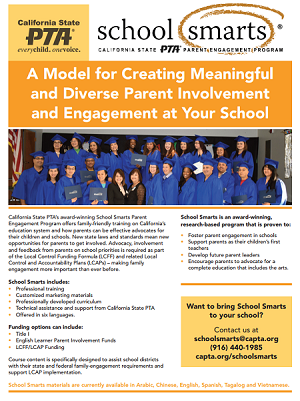
The School Smarts Parent Engagement Program is a model for creating meaningful and diverse parent involvement. It brings parents from all backgrounds together in support of their common interest: helping their children and schools succeed.
Download:
Working together, parents and teachers give kids their best chance to learn. The California Teachers Association and the California State PTA have joined forces to offer some tips for you that will give your children the best opportunity to succeed in school.
 Download the information, available in multiple languages:
Download the information, available in multiple languages:
State tests are an objective way of showing how well students met the expectations of the grade level. They are only one of many measures and aren’t meant to tell the whole story of a student’s performance. They should be combined with other information, such as report card grades, classwork and teacher observations to give families a more complete picture of their child’s academic performance.
In California, students in third through eighth and 11th grade take the Smarter Balanced test in English language arts and math. It is part of the state assessment system known as the California Assessment of Student Performance and Progress (CAASPP).
Depending on school calendars, testing in English Language Arts, mathematics, and science takes place mostly in April and May. Parents should receive their children’s reports soon after testing in their district is completed.
The Smarter Balanced state assessment is focused on grade level material and is aligned to the state standards. The test questions match what students do and learn in the classroom everyday throughout the year, which are the skills that are most important for students to learn in order to move on to more challenging content.
The Smarter Balanced test is taken online and is computer adaptive, which means it adjusts the difficulty of the questions based on the student’s responses. The test includes a variety of different types of questions, including traditional multiple choice, ones that ask students to show their work and explain their answer, and questions that ask students to analyze text and write a well-developed essay. California teachers have worked closely with the state to write and review test questions.
National PTA developed the Family Guide to the Annual State Test which includes general information about the Smarter Balanced test, including grades and subjects tested, how the results are used and links to additional resources.
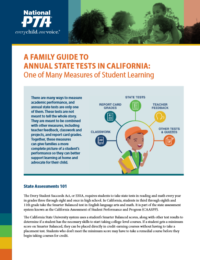
The score report gives families information on how well their child performed on different sets of skills in each subject. Families can use this information to identify where their child is doing well and where they may need support or practice. This helps families better support learning at home. It can also help them to start meaningful conversations with teachers, to set goals for each student’s areas of improvement and to identify resources and strategies that can be used at home and in school to help students make progress.
A new resource designed specifically with district and council level advocacy chairs in mind, to support your advocacy efforts.
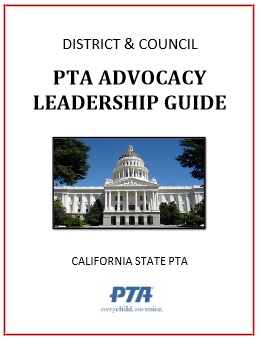 Download the Advocacy Leadership Guide.
Download the Advocacy Leadership Guide.
Cada niño, una sola voz. Con más que 750,000 miembros, la mision de la associacion de padres y maestros (PTA por sus siglos en ingles) de California es de impactar positivamente las vidas de todos los ninos y las familias. La PTA se enfoca en cuatro areas principales: educacion, salud, participacion de los padres y asuntos comunitarios.
PTA trabaja para dar fuerzas a todos los padres y cree que juntos podemos hacer una realidad el potencial de cada niño. Te invitamos a utilizar nuestros recursos, ayudarnos a identificar otras nuevas, y háganos saber cómo podemos mejorar nuestra información y herramientas para mejor apoyar a ustedes como padres.
“Sabías?”
Desde del ano 1897, PTA ha sido instrumental en:
¿Qué quieres para sus hijos? ¿Cómo vas a trabajar para mejorar la educación de su hijo? Sea cual sea su necesidad o interés, PTA está aquí para ayudarles.
PTA Resolutions come from our members and call attention to a problem and a need for action on a particular issue. They are a major source of authority for the California State PTA and its units, councils, and districts. If a problem or situation has statewide implications affecting children, youth, and families, a resolution is one way to authorize PTA action. Other sources of PTA authorities include National PTA resolutions, California State PTA and National PTA position statements, and legislation platforms. See the full list of our Resolutions.
PTA Resolutions are not legislation and are very different from those that you may be familiar with from your local School Board or City Council. PTA Resolutions provide direction (authority) for our membership to take action. Our Resolutions are not direct advocacy messages to state or federal legislators or position statements. Authority allows us to take a position on legislation, policy, and ballot measures. Resolutions may only be authorized by delegates to the California State PTA’s Annual Meeting (Convention), using the procedures outlined in the California State PTA Resolution Procedure Book. Units, Councils, and Districts cannot authorize Resolutions.
Click here for information on how to submit a PTA Resolution
Resolutions are PTA Authorities created by members and adopted by the membership at the Annual Meeting (California State PTA Convention). Resolutions call attention to a problem and need for action by our membership on a particular issue.
The deadline to submit a Draft Resolution to California State PTA is November 1st. The deadline to submit a Final Resolution to California State PTA is January 5th. There is no set start date for work to begin. Resolution Makers, who have an authorization vote to begin the Resolution process, from a PTA association, may submit a Draft Resolution at any time prior to the November 1 due date.
The California State PTA Resolution Procedure Book defines the process to help makers develop their resolution. Please note, if the work begins during one term and continues into the next, a vote from the new association must be obtained to continue developing the resolution.
PTA Resolutions must meet the criteria defined in the California State PTA Resolutions Procedure Book. The length of time to research and write a PTA Resolution depends on the author. There are some firm dates, however:
A PTA member or group of members of a unit, council, or district identifies an issue of concern and determines the need for a resolution. One PTA member must chair or lead the committee and is often referred to as the “maker” of the resolution. More information can be found in the California State PTA’s Resolution Procedure Book.
The Resolutions Procedure Book is the best place to start with any resolution-related questions.
Endorsements (letters of support) can be made by PTA Units, Councils, Districts, and the California State PTA Board of Managers as well as community or education organizations. Endorsements are sought by the maker prior to the California State PTA Winter Board of Managers to show support as a resolution is considered for the Annual Meeting agenda. Endorsements can also be voted on by PTA Associations after review and discussion, typically as part of delegate selection/training in preparation for the Annual Meeting. There is no need to do a work-study to endorse a PTA Resolution.
The California State PTA strongly encourages its Unit, Council, and District PTAs to budget for and send as many delegates (voting and non-voting) as possible to each Annual Meeting. Prior to the convention, units, councils, and districts are encouraged to review, discuss and vote on the resolutions to guide delegate action at convention. An endorsement may also be made at this time. Delegates vote according to the association’s intent as their representative.
All delegates are welcome at hearings. Voting delegates should plan to attend at least one Resolution Hearing and all General Meetings to exercise their voting obligation. More information on Annual Meeting (convention) delegates and representation at the convention is outlined in the California State PTA Bylaws, Article XV, Section 5, or request assistance from your PTA District leaders.
Achievement: Eliminating the Gap (2009)
Adequate and Equitable State School Finance System (1987)
Aid to Survivors of Sexual Violence (2023)
Air Pollution (1973)
Alcohol and Tobacco Use in Youth: Education, Prevention and Intervention (2002)
Alcohol Beverage Advertising that Targets Youth (1992)
Alcohol-Related Driver Education (1982)
Antibiotic Resistance Awareness (2001)
Arts Education (1998)
Attention Deficit Disorder in Children (1998)
Automated External Defibrillator (AED) Awareness in Schools (2011)
Background Checks of Ice Cream Truck Vendors (1986)
Ballot Propositions (initiatives) (1999)
Ban on Drug Paraphernalia (1981)
Ban on Military Assault-Type Weapons (1989)
Ban on the Manufacture and Sale of Saturday Night Specials/Junk Guns (1997)
Bicycle Safety Education and Training (1973)
Bicycle Safety Helmets (1991)
Breakfast in Every School (2003)
Breast Cancer Early Detection Awareness and Education (1988)
California K-12 Public School Funding Crisis (1998)
Cannabis and Youth Health and Safety (2024)
Child Trafficking in California (2010)
Citizenship Education (1989)*
Class Size Reduction (1996)
Climate Change is a Children’s Issue (2015)
Closed Captioned TV (1978)
Comprehensive Waste Reduction in Schools (2007)
Computer Technology in Education (1983)
Computer Workstation Health (2010)
Control of Look-Alike Stimulants and Depressant Drugs (1982)
Creating Lifelong Readers (1998)
Credential Requirement: Parent/Family Involvement Component (1993)
Credentialed School Nurses (2005)
Desegregation and Neighborhood Schools (1979)
Developmentally-Appropriate Physical Education (1999)
Disaster Preparedness (1986)
Drug Advertising (1970)
Duplicate Emergency Forms at Athletic Events (1974)
Dyslexia: Addressing the Educational Implications in Public Schools (2016)
E-Cigarettes/Vaping, Flavored Tobacco Products and Youth Health (2020)
Early Childhood Development and Education (2000)
Early Care and Education for All of California’s Children (2019)
Education: A 21st Century Vision (2005)
Education on Hazards of Involuntary Smoking (1987)
Education on Health Hazards in the Use of Anabolic Steroids (1989)
Educational Technology Funding (1995)
Educational Testing and Test Scores (1971)
Electro-Magnetic Fields (1994)
Emergency School Bus Evacuation (1973)
Equal Access to School Improvement Program Funds (1983)
Equitable Literacy for All Students (2023)
Family Preservation: An Alternative to Out-of-Home Placement (1990)
Financial Literacy for Youth (1999)
Financing California’s Public Schools (2007)
Firearm Safety and Awareness (1995)
Firearm Safety Devices (1999)
Fireworks: Hazards to Youth (1990)
First Aid and/or Cardiopulmonary Resuscitation (C.P.R.) (1987)
Food Allergy and Anaphylaxis in Schools (2004)
Football Safety (1975)
Foster Families (1999)
Funding Sources for Adult Crossing Guards (1981)
Grade Retention (1991)
Hazardous Waste Management (1980)
Healthy Lifestyles for All Children (2004)
HIV/STD Prevention Education in Our Schools (2008)
Homeless Families with Children (1989)
Homework: Quality Over Quantity (2014)
Hot Weather Standards in the School Setting (1992)
Immunization Awareness and Educational Programs (1975)
Improving and Stabilizing Education Funding (2018)
Improving K-12 Mathematics Education (1998)
Inclusive Education for Students with Cognitive Disabilities (2023)
Inclusive Schools Build Stronger Communities (2013)
Increase Funding for Chronic Diseases & Injury Prevention (2020)
Increased School Nurse-to-Student Ratios (1997)
Increasing Counselor-to-Student Ratio in Schools (2000)
Individuals with Disabilities Education Act (IDEA) Underfunding (2007)
Indoor Air Quality (IAQ) in Schools (2007)
Internet Access for California Classrooms (2000)
Juvenile Justice Reform – A Priority (1983)
Learning Disabilities and Learning Disabilities in Gifted Children (2000)
LGBTQ+ Inclusiveness in Health Education California (2015)
Licensing and Registration of Handguns (2000)
Limiting Concurrent Sales of Gasoline and Alcohol and the Proliferation of Outlets (1985)
Literacy Education (1989)
Local School Parcel Tax Measure Threshold Reduction (2008)
Longitudinal Integrated Statewide Data System (2008)
Lowering the 2/3 Vote Requirement on School and Library Bonds (1999)
Lowering the Vote Requirement in the California State Budget Process (2009)
Measles (Rubeola) Vaccinations (1990)
Mental Health Services for Our Children and Youth (2020)
Mental Illness: Treatment and Support (1999)
Minimum Instruction Time (1983)
Missing and Murdered Indigenous Women, Children, and Two Spirit Individuals (2024)
Missing Non-Abducted Children with Cognitive Disabilities (2025)
Mitigating Earthquake Hazards in Public Schools (1989)
Net Zero Emission Schools (2020)
Nonsuspension of Proposition 98 (1991)
Nutrition Education (1991)
Online Safeguards for Internet Use by Children and Youth (1997)
Opposition to Televised Commercials in California Classrooms (1990)*
Organ and Tissue Donor Awareness (1999)
Paintball Gun Control (1993)
Parent/Community Action for Effective Schools (1993)
Pedestrian Safety Education (1990)
Pesticides (1972)
Plant Based Food Options at School Meals (2022)
Playground Equipment Safety Standards (1996)
Playground Surface Safety (2002)
Post Proposition 13 Funding of Public Education (1979)
Primary Prevention of Substance Abuse (1979)
Prohibiting the Promotion of Tobacco Products (1987)
Property Tax Limitation (1978)
Protection of Children from the Harmful Effects of Aircraft Emissions (1998)
Public School Governance Authority (2007)
Qualifications for Candidacy in California Elections (2013)
Quality of Life Portrayed on Television (1979)
Regulation of Liquor Licenses Near Schools (1997)
Regulation of the Display and Sale to Minors of Drug-Use Information and Paraphernalia Including Cigarette Papers (1979)
Returning to the Classroom Following Student Concussions (2024)
Safe Routes to School for All Children (2008)
Safety Helmets for Scooter, Skateboard and Skate Users Under the Age of 18 (2001)
Safety Problems Related to Freeway Construction Near Schools (1970)
Sale of Tobacco Products to Minors (1988)
Save Our Kids (1983)
School Absenteeism/Dropouts (1986)
School Buildings and Railroad Safety Requirements (1990)
School Bus Safety (1993)
School Construction Funding (1986)
School Desegregation Through Housing Integration Incentives (1982)
School Facilities and Public Planning (1991)
School Facilities Crisis (1990)
School Funding (1981)
School Library Media Center Funding Crisis (1988)
School Nutrition Programs: Improvement and Expansion (1991)
School Support Program (1976)
School Traffic and Pedestrian Safety Improvement (2001)
School Transportation (1981)
School Transportation: Equitable Funding (2004)
School-to-Career for All Students (2001)
Science, Technology, Engineering and Mathematics (STEM) Education (2011)
Scoliosis Screening (1980)
Seat Belt and Child Restraint Usage (1983)
Self-Esteem and Personal and Social Responsibility Awareness (1991)
Smoking and Health (1964)
Social Host Accountability and Underage Drinking (2009)
State Government Responsibility for a Rational Budget Process (1992)*
State Tax Reform (1991)
Strategies to Reduce School, Family and Community Violence (1995)
Student Assessment, Achievement and Accountability (2000)
Student Substance Abuse: Alternatives to Zero Tolerance (2003)
Substance Use and Abuse During Pregnancy (1987)
Suicide Prevention Education and Awareness (1983)
Summer Learning Loss (2013)
Summer School (1980)
Sun Safety: Skin Cancer Prevention Measures at School (2005)
Support and Funding for Voluntary Integration Programs (1980)
Support for the Civic Mission of Schools (2006)
Support for Quality Child Care (1986)
Support of Public Education, PTA Priority (1980)
Synthetic and Tobacco-Free Nicotine Products (2023)
Synthetic Marijuana – Education and Awareness (2015)
Teacher Preparation for Elementary Education (1973)
Teacher Quality: Recruitment, Retention and Resources (2001)
Teaching Hard History: American Slavery in K-12 Education (2021)
Teen Driving Safety (2009)
Television Literacy and Program Accountability (1993)
Television/Screen Time Awareness (2006)
Temperature Control Standards in the School Setting (2019)
Threatening Phone Calls to Schools (1990)
Tobacco Advertising That Targets Minors (1993)
Torture Toys (1972)
Toxins (Persistent and Bioaccumulative) and Their Effects on Children (2002)
Treatment Centers for the Sexually Abused (1978)
Trees for Life (1989)
Tuition Tax Credits (1982)*
Use of Children as Subjects in Pornographic Materials (1977)
Violence and Vandalism (1980)
Violence in the Home (1977)
Violence Prevention in Schools (1999)
Weapons on Campus (1973)
Youth Involvement (2004)
Starred (*) titles represent resolutions adopted by California State PTA Board of Managers. (These were not voted upon by Convention delegates.)
 We all experience emotional ups and downs from time to time caused by events in our lives. Mental health conditions go beyond these emotional reactions and become something longer lasting. They are medical conditions that cause changes in how we think and feel and in our mood. They are not the result of personal weakness, lack of character or poor upbringing.
We all experience emotional ups and downs from time to time caused by events in our lives. Mental health conditions go beyond these emotional reactions and become something longer lasting. They are medical conditions that cause changes in how we think and feel and in our mood. They are not the result of personal weakness, lack of character or poor upbringing.
With proper treatment, people can realize their full potential, cope with the stresses of life, work productively and meaningfully contribute to the world. Without mental health, we cannot be fully healthy.
A healthy lifestyle can help to prevent the onset or worsening of mental health conditions like depression and anxiety, as well as heart disease, diabetes, obesity, and other chronic health problems. It can also play a big role in helping people recover from these conditions. Taking good care of your body is part of the key to maintaining good mental health.
Getting the appropriate amount of exercise can help control weight, improve mental health, and help you live longer and healthier. Recent research is also connecting your nutrition and gut health with your mental health. Sleep also plays a critical role in all aspects of our life and overall health. Getting a good night’s sleep is important for having enough physical and mental energy to take on daily responsibilities. And we all know that stress can have a huge impact on all aspects of our health, so it’s important to take time to focus on stress-reducing activities like meditation or yoga.
There’s emerging evidence that positive mental health is associated with improved overall health outcomes, and that social-emotional and behavioral health in young children is an important component of school readiness.
But research also shows that mental illnesses and disorders — especially depressive disorders — are strongly related to the occurrence, successful treatment and course of many chronic diseases including diabetes, cancer, cardiovascular disease, asthma, and obesity and many risk behaviors for chronic disease like physical inactivity, smoking, excessive drinking, and insufficient sleep.
In the medical and public health arenas, more emphasis and resources have been devoted to screening, diagnosis, and treatment of mental illness than mental health. Little has been done to protect the mental health of those free of mental illness. We need to do more to help people of all ages strengthen their mental health.
 We know what it takes to keep a child physically healthy — nutritious food, exercise, immunizations — but the basics for good mental health aren’t always as clear. The first “basic” is to know that children’s mental health matters. We need to treat a child’s mental health just like we do their physical health, by giving it thought and attention and, when needed, professional help.
We know what it takes to keep a child physically healthy — nutritious food, exercise, immunizations — but the basics for good mental health aren’t always as clear. The first “basic” is to know that children’s mental health matters. We need to treat a child’s mental health just like we do their physical health, by giving it thought and attention and, when needed, professional help.
Although there can be a genetic or biological component to mental illness, many children live in unsafe environments that put them “at-risk” of developing mental health problems. According to the U.S. Surgeon General’s Office, there are social determinants of mental health that need to be in place for our children: adequate housing, safe neighborhoods, equitable jobs and wages, quality education and equity in access to quality health care.
The consequences of mental illness may often be prevented through early intervention. At the very least, it is possible to delay mental illness and/or lessen symptoms. The best way to promote children’s mental health is to build up their strengths, help to “protect” them from risks and give them tools to succeed in life.
Promoting a child’s mental health means helping a child feel secure, relate well with others and foster their growth at home and at school. We do this by helping to build a child’s confidence and competence — the foundation of strong self-esteem. This can be achieved by providing a child with a safe and secure home; warmth and love; respect; caring and trusting relationships with family, friends, and adults in the community; opportunities to talk about experiences and feelings; time to play, learn, and succeed; encouragement and praise; and consistent and fair expectations with clear consequences for misbehavior.
If there is a concern that a child may be experiencing a mental health problem, it is important for adults to seek help from a doctor or mental health professional. Just like with physical illness, treating mental health problems early may help to prevent a more serious illness from developing in the future.
 Care for your children’s mental health just as you do for their physical health
Care for your children’s mental health just as you do for their physical healthMental disorders in children are treatable. Early identification, diagnosis and treatment help children reach their full potential and improve the family dynamic. Children’s mental health matters! To learn more, talk to a doctor, mental health professional.
From: Mental Health America — Children’s Mental Health Matters Fact Sheet
California PTA members are dedicated to expanding mental-health supports and services for our kids. Get the latest mental-health news through our email alerts, and stay in touch with your local PTA for the latest information on mental health services and supports at your school.
Since 1949, Mental Health America and its affiliates across the country have led the observance of May is Mental Health Month by reaching millions of people through the media, local events, and screenings. They welcome other organizations to join them in spreading the word that mental health is something everyone should care about by using the May is Mental Health Month toolkit materials and conducting awareness activities.
Learn more and download a Toolkit for your PTA.
California’s education system is changing fast. You want to help. Learn how it all fits together with Ed100!
California State PTA and Ed100.org teamed up to help parents learn more about education so you can help create better schools.
Explore the education system in easy-to-understand language. No jargon. No partisan slant. Written by education experts who know Sacramento and local schools.
Ed100 is a free online resource that prepares you to make a difference in your school or school district. It helps you learn what you need to know to be informed, credible and ready for action.
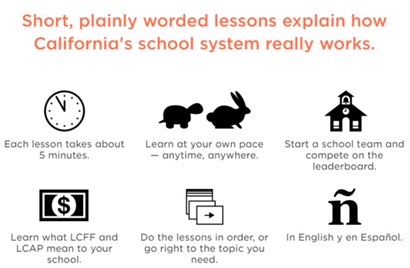
Every California child deserves a great education. With Ed100, you can be part of the solution.
Ed100 Parent Leader Guide
The Parent Leader Guide provides “ready-to-go” plans for parent meetings. We want to help you hold meetings that matter. It’s all here: Lessons, discussion prompts, handouts and suggestions for taking action.
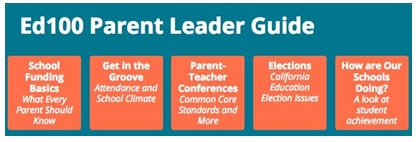
Here are 15 ways to improve arts education in California, grouped by the level of commitment each requires:
|
GOT A MINUTE OR TWO? |
GOT AN HOUR OR TWO? |
GOT A DAY OR TWO? |
|
|
|
 Research shows that learning arts subjects alongside math, history, science and English has an exponential effect on student success. For example, students who have an arts education achieve more A grades (in all subjects), have better attendance, are more likely to graduate from high school, and have better critical thinking, collaboration and social-emotional skills than those who don’t. This is especially true for English language learners and students from low-income backgrounds.
Research shows that learning arts subjects alongside math, history, science and English has an exponential effect on student success. For example, students who have an arts education achieve more A grades (in all subjects), have better attendance, are more likely to graduate from high school, and have better critical thinking, collaboration and social-emotional skills than those who don’t. This is especially true for English language learners and students from low-income backgrounds.
The good news continues even after high school. Kids with an arts education are more likely to graduate from college, and are more likely to pursue a professional career. Creative arts learning also boosts chances for employment once kids become adults and move into the working world: 72% of business leaders – across all industries – say that creativity is the #1 skill they are seeking, and one out of every 10 jobs in California is in a creative industry.
Be sure to watch this video from the California Alliance for Arts Education on how arts education is being implemented in Chula Vista – and making a difference in the lives of children.
“STEM” stands for Science, Technology, Engineering, and Mathematics education. Add Art and you have “STEAM.”
Is it STEM or STEAM? The opinions on that aren’t unanimous, but most parents and families agree about the end goal – that school curriculum should foster innovation, develop 21st century skills, and teach young people to think both logically and creatively.
Today, the fastest growing job sectors are related to science, technology, engineering, arts and math (STEAM) and 60% of college majors require a math background. Smart phones, computer-equipped cars and self-regulating appliances are just a few reminders of how pervasive technology is in our lives. We also know more technology-driven change will occur during the lifetime of our children.

It’s clear that young people with competency in the STEAM disciplines are more likely to prosper both in their lives and in their careers.
Building the capacity of young people in science, technology, engineering and math — and doing so within the humanistic frame that the arts help provide — is essential. Young people will need a high level of STEAM literacy to make decisions about their daily lives and to fulfill their role as informed citizens.
Today’s young people are already finding that more and more jobs require proficiency in STEAM disciplines. Our schools need to make sure they’re prepared.
California State PTA took particular interest in STEM/STEAM education with the 2011 passage of the resolution “Science, Technology, Engineering and Mathematics (STEM) Education” resolution and PTA has advocated for bills and policies related to STEM education many times since.
Families Are an Important Part of the STEAM Equation
Research from National PTA emphasizes the essential role of family engagement in increasing students’ access to opportunities in science, technology, engineering, arts and math — especially among girls and under-represented youth. Read the STEAM White Paper.
Five Tips for Parents
Science is the S in STEAM — the acronym now often used when people want to talk about science, technology, engineering, art and math as a set of connected school subjects.
California schools are taking a new approach to science, thanks to the state’s adoption of the Next Generation Science Standards (NGSS). The standards call on schools to introduce science to students beginning in kindergarten in order to fuel kids’ innate curiosity and ignite a lifelong interest in science and engineering. That’s especially important for students who don’t think of themselves as “science kids.”
When educators talk about NGSS they may mention “three dimensional learning.” 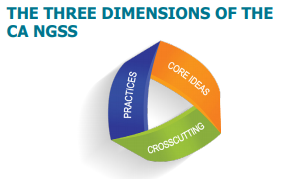
Building Knowledge and Understanding Over Time
Here is an example of what a child might experience in science as they go through school. Earth’s Systems is the NGSS “Disciplinary Core Idea” being taught.
As young people get older, they learn progressively more about the topic of weather while they also develop their ability to use scientific practices such as data collection and analysis. Even in kindergarten, they begin gaining familiarity with crosscutting concepts — such as patterns and stability versus change — that are used in every science domain.
At every grade level, this new approach to teaching science is designed to be more engaging and interactive, aligning with how kids learn best. The new standards encourage students to ask lots of questions and emphasize hands-on investigation and discovery. The new standards will also allow teachers to be more innovative and creative in the ways they teach science.

In a PTA-sponsored survey of parents throughout California, 9 out of 10 parents agreed that learning science is equally important as reading, writing and math. Parents know science matters but only about half said they were satisfied with the amount of science education their child was getting in school. Many people hope that the state’s on-going work to transform how schools teach science will help change that.